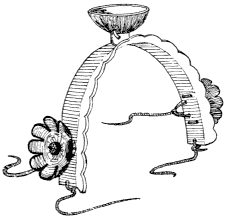Gourds.
—The gourd was one of the aboriginal plants cultivated by the Pueblo Indian before the advent of the Spaniards. It has an important place in both their ceremonial and domestic lives. The gourd, in fact, is indispensable to the Pueblo Indian; it is a bucket, a dipper, or a bowl as the need arises. Several species were grown. Some were small, some were long-necked, and others grew flat or round. By running the vine on a pole so that the green fruit hung down it was possible to develop extremely long, thin gourds; and it was possible to flatten them out by placing a weight on one side. Under stimulating conditions very large gourds have been grown. There are two masks made of gourds in the Museum of the American Indian, Heye Foundation.[85] One of them is large enough for a man to wear. With the lower end cut off, it would go over his head and rest upon his shoulders. There were holes for eyes and mouth. A smaller gourd made the snout, and the features were painted on. The other mask could have been worn by a boy.
The shell of the gourd is scraped clean of seeds and pulp and then thoroughly dried. As the gourd is a material more easily worked than wood, and, for the Hopi and the ZuÑi, much more easily available, it is made into snouts and beaks and ear bobs for masks. A large number of these are kept on hand at all times, to be available for any dance ceremonies. Rarely, two gourds will grow so much alike that the necks can
be used as horns on an animal mask. When several are found of the same size and shape, they are carved into flowers to decorate a headdress or arm bands. The heads of the sacred Plumed Serpents are made of gourds.[86] The mouth is cut to show two rows of teeth, between which a red leather tongue is allowed to dangle. Gourds are made into rattles, round or fiat, with the necks serving as handles (fig. 20, p. 146). Certain phallic devices are made of the long variety of gourds and these symbolize fructification.[87]

Figure 13.
Headdress with flowers made of grounds.